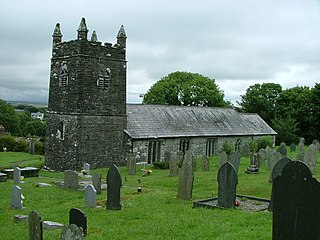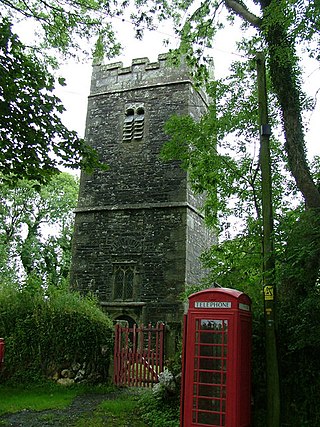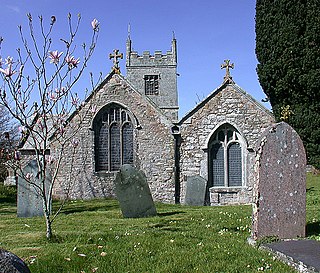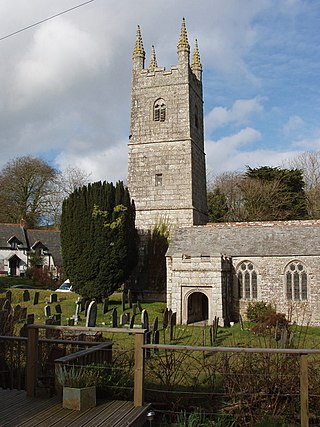
St Keverne is a civil parish and village on The Lizard in Cornwall, England, United Kingdom.

Warbstow is a village and civil parish in Cornwall, England, United Kingdom. The parish has a population of 439 according to the 2001 census, increasing to 520 at the 2011 census.

St Mabyn is a civil parish and village in Cornwall, England, United Kingdom. The village is situated three miles (5 km) east of Wadebridge. The parish includes a hamlet called Longstone to the east and many small manor houses, including Tregarden, Tredethy, Helligan Barton and Colquite, all built in the 16th and 17th centuries. The area of the parish is 4,101 acres (16.60 km2).

St Agnes is a civil parish and town on the north coast of Cornwall, England, United Kingdom. The village is about five miles (8 km) north of Redruth and ten miles (16 km) southwest of Newquay. An electoral ward exists stretching as far south as Blackwater. The population at the 2011 census was 7,565.

Crowan is a village and civil parish in Cornwall, England, United Kingdom. It is about three-and-a-half miles (6 km) south of Camborne. A former mining parish, all of the mines had shut by 1880.
St Kew is a village in Cornwall, England, United Kingdom. It is also the name of the civil parish, which includes the church town, St Kew, and nearby St Kew Highway.

Helland is a civil parish and village in Cornwall, England, United Kingdom. It is situated 2+1⁄2 miles (4.0 km) north of Bodmin. The meaning of the name Helland is unclear: it is possible that the origin is in Cornish hen & lan. The original dedication of the church is unknown but St Helena is now recognised as the patron.

Otterham is a village and a civil parish in north Cornwall, England, United Kingdom. The village is situated approximately ten miles (16 km) south of Bude and six miles (9.7 km) north of Camelford.

Tremaine or Tremain is a small village and a rural civil parish in east Cornwall, England, United Kingdom. It is in the Registration District of Launceston and the population in the 2001 census was 87. It had decreased to 53 at the 2011 census. There is also a dairy farm called Ash Grove farm.

Insworke is a hamlet in the parish of Millbrook in southeast Cornwall, England, UK. A fair and annual market were held here from 1319.

Prospidnick is a small village and hill in the parish of Sithney in Cornwall, United Kingdom. It lies 0.6 miles east of Crowntown and 2.6 miles west of Wendron by road. It is divided into Lower Prospidnick and Higher Prospidnick.

Withielgoose or Withel-goose is a hamlet in Cornwall, England, UK. Withielgoose, from the Cornish gwyth (trees), yel and coes (wood) suggests the clearance of woodland to create agricultural land. The hamlet is accessed via Withielgoose Lane and contains Withielgoose Manor. Withielgoose belongs historically to the parish of Withiel along with Retire and Tregawne; the parish had a total population of about 300 in 1824. It lies about five miles west of Bodmin and six miles east north east of St Columb Major.

Colan Church also known as St Colan Church is a 13th-century church in Colan, mid-Cornwall, UK. Dedicated to St Colanus, it became a Grade I listed building in 1967. The vicars of St Columb Minor have served the church since the middle of the 20th century.
Trenant Park is a Grade II listed country house in the civil parish of Duloe in east Cornwall, England, UK. It is surrounded by a large park and woodland. It is sited on a tongue of land between the East and West Looe rivers. The house was possibly built in the early 17th century, remodelled in the early 18th century, extended in the mid 19th century and divided into flats in the 20th century.

St James’ Church, Jacobstow is a Grade I listed parish church in the Church of England in Jacobstow, Cornwall.

St Mary the Virgin's Church, Week St Mary, also known as the Church of the Nativity of the Blessed Virgin Mary, is a Grade I listed parish church in the Church of England Diocese of Truro, in Week St Mary, Cornwall, England, UK.

St Anne's Church, Whitstone is a Grade I listed parish church in the Church of England Diocese of Truro in Whitstone, Cornwall, England, UK.

St Winwaloe's Church, Poundstock is a Grade I listed parish church in the Church of England in Poundstock, Cornwall.

St Werburgh's Church, Warbstow is a Grade II* listed parish church in the Church of England in Warbstow, Cornwall.

St Gregory's Church, Treneglos is a Grade II* listed parish church in the Church of England in Treneglos, Cornwall.



























